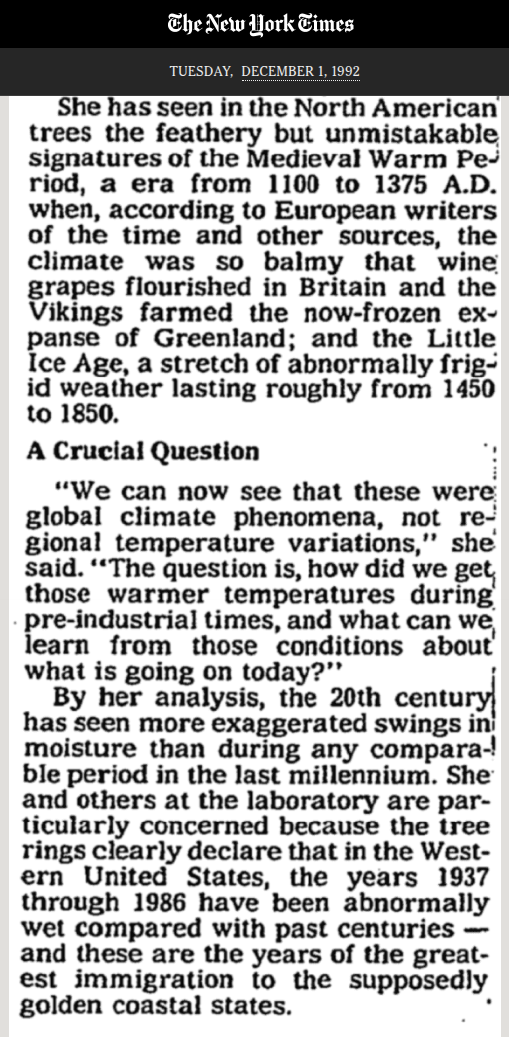“Lisa J. Graumlich, who examines the ring patterns of foxtail pine trees and western junipers in the Sierra Nevada, has compiled a detailed record of the year-to-year variation in temperature and precipitation over the last thousand years.
She has seen in the North American trees the feathery but unmistakable signatures of the Medieval Warm Period, a era from 1100 to 1375 A.D. when, according to European writers of the time and other sources, the climate was so balmy that wine grapes flourished in Britain and the Vikings farmed the now-frozen expanse of Greenland; and the Little Ice Age, a stretch of abnormally frigid weather lasting roughly from 1450 to 1850. A Crucial Question
“We can now see that these were global climate phenomena, not regional temperature variations,” she said. “The question is, how did we get those warmer temperatures during pre-industrial times, and what can we learn from those conditions about what is going on today?”
By her analysis, the 20th century has seen more exaggerated swings in moisture than during any comparable period in the last millennium. She and others at the laboratory are particularly concerned because the tree rings clearly declare that in the Western United States, the years 1937 through 1986 have been abnormally wet compared with past centuries — and these are the years of the greatest immigration to the supposedly golden coastal states.”
Disrupting the Borg is expensive and time consuming!
Google Search
-
Recent Posts
- “Earlier Than Usual”
- Perfect Correlation
- Elon’s Hockey Stick
- Latest Climate News
- “Climate dread is everywhere”
- “The Atmosphere Is ‘Thirstier.’”
- Skynet Becomes Self Aware
- “We Have To Vote For It So That You Can See What’s In It”
- Diversity Is Our Strength
- “even within the lifetime of our children”
- 60 Years Of Progress in London
- The Anti-Greta
- “a persistent concern”
- Deadliest US Tornado Days
- The Other Side Of The Pond
- “HEMI V8 Roars Back”
- Big Pharma Sales Tool
- Your Tax Dollars At Work
- 622 billion tons of new ice
- Fossil Fuels To Turn The UK Tropical
- 100% Tariffs On Chinese EV’s
- Fossil Fuels Cause Fungus
- Prophets Of Doom
- The Green New Deal Lives On
- Mission Accomplished!
Recent Comments
- Bob G on “Earlier Than Usual”
- MLH on “Earlier Than Usual”
- Gordon Vigurs on Perfect Correlation
- Jack the Insider on “Earlier Than Usual”
- Bob G on “Earlier Than Usual”
- John Francis on “Earlier Than Usual”
- John Francis on “Earlier Than Usual”
- Terry Shipman on “Earlier Than Usual”
- arn on “Earlier Than Usual”
- Gordon Vigurs on “Earlier Than Usual”



Having higher temperatures and more rain
is exactly what a balanced climate needs.
PS – the massive increase of the Chinese population during the MWE is another indicator that the MWE was indeed all over the planet.
edit
MWP not MWE.
This is an interesting article, not only confirming the MWP and the Little Ice Age, but more for me, a great indicator of how much the “climate” can appear to swing within a singular climatic period. In 1000 years, a short period within of the post Ice Age climate phenomena, we have the Medieval Warm Period and the Little Ice Age, and now ostensibly a Post Little Ice Age, which I’m not so sure of. Yet this period in the overall swing of things is an interglacial climatic period. How can modern scientist get it so out of context? We are either between glaciations, or we have broken the cycle of glaciations and are in a long warm period, which will be a boon for life in general.
‘“Lisa J. Graumlich, who examines the ring patterns of foxtail pine trees and western junipers in the Sierra Nevada, has compiled a detailed record of the year-to-year variation in temperature and precipitation over the last thousand years.
‘She has seen in the North American trees the feathery but unmistakable signatures of the Medieval Warm Period’
Sorries. Don’t believe it. It is impossible to tease out whether greater growth rings were due to temperature OR precipitation. With the MWP in Europe, temperature is a good candidate, but the rings don’t know.
Plus Europe and the Sierras do not a world event make. Evidence for it, but not conclusive.
@Gamecock: in a comments thread I once asked a “climate scientist” how he knew when to use a tree as a thermometer, when as a rain gauge.
His reply was, effectively, “How dare you?!” followed by an assurance that science revealed such things.
“a stretch of abnormally frigid weather lasting roughly from 1450 to 1850”
That’s a myth, between the centennial solar minima, hot weather still happens. Like the 1530’s, especially 1540. The 1610’s, 1630’s, and 1650’s were very warm.